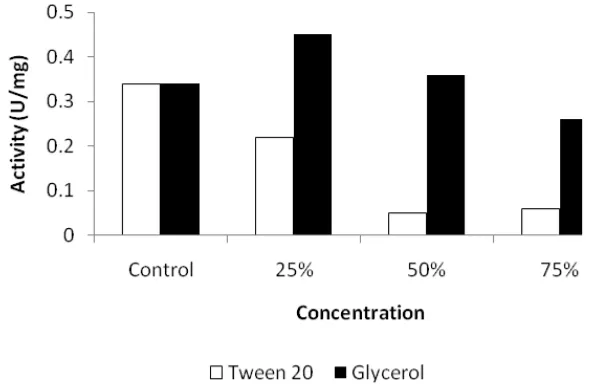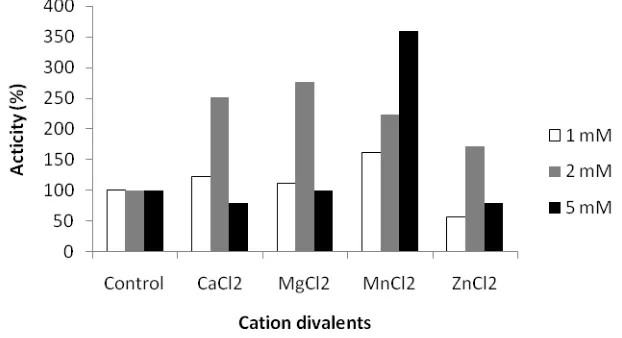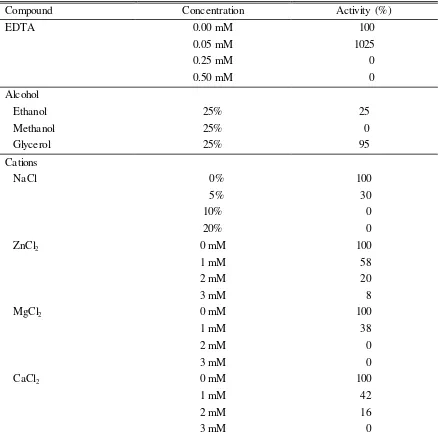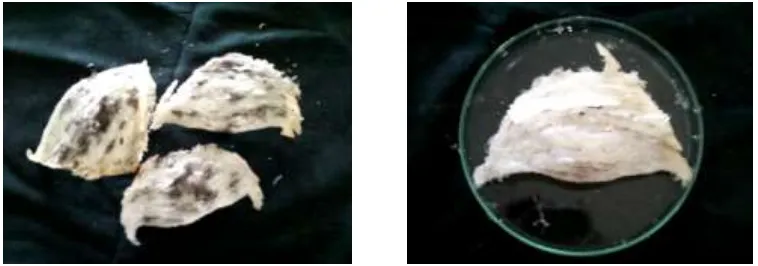Formulation of Crude Enzymes from
Bacillus
sp. MTS for Cleaning
Solution
Rahayu S1, Suhartono MT2, Suryapratama W1
1)Faculty of Animal Science, Jenderal Soedirman University
Jl. Dr. Soeparno Purwok erto 53123, Central Java, Indonesia
2)Department of Food Science and Technology, Faculty of Agricultural Technology
Bogor Agricultural University, Jl. Raya Darmaga Kampus IPB, Bogor 16680, Central Java, Indonesia [email protected]
ABSTRACT
Edible bird’s nest (EBN) as a kind of functional food has high economic value depending on the quality such as color and hygiene. The purpose of this research was to find the optimum condition for application of keratinolytic enzymes of Bacillus sp. MTS in cleaning EBN. Activating agents for both enzymes were cation divalents, EDTA, reducing agents, organic solutions, and antibacterial agents. Additive compounds that able to increase keratinase activity were used to make cleaning solution and they were tested on EBN and human hair.
Alcoholic solutions (25% ethanol, 25% methanol, 25% glycerol), and some divalent metallic ions (Ca2+, Mg2+, Mn2+, Zn2+) were able to increase keratinase while disulfide reductase was solely activated by 0.05 mM EDTA. The activity of both enzymes was inhibited by NaCl and Na -azide. The activity of keratinase of Bacillus sp. MTS in cleaning solution formulated in this research was 2-3 fold as much as control (crude extract) in human hair substrates. Glycerol and cations divalent increasing 2-3 fold keratinase activity in cleaning solution. The solution was successfully applied to cleaning EBN with weight loss approximately 2.3-2.5%.
Key Words: Keratinase, Bacillus, Cleaning, Edible Bird’s Nest
INTRODUCTION
Edible bird’s nest (EBN) contains the saliva of swiftlets birds. Two types of EBN, the
white-nest produced by Aerodramus fuciphagus and the black-nest by Aerodramus
maximus (Goh et al. 2001). The EBNs contain high quality nutrients, protein, carbohydrate, iron, inorganic salts and fiber, and bilieve to function as antiaging, anticancer, immunity enhancing agent, inhibit influenza virus infection and improve respiratory and digestive problems (Marcone 2005; Hamzah et al. 2013; Huda et al. 2008; takes a time-consuming manual process to singly discard the feathers using pincers.
The commonly used cleaning solution among the farmers/collectors is chemical-based
solution containing hydrogen peroxide (H2O2) known as whitening/bleaching agent.
to Bacillus sp. MTS (Rahayu et al. 2010) .This bacillus was mesophillic aerobic, and very effective in degrading whole chicken feather. This activity appears to be related to the extracellular keratinase and disulfide reductase enzymes. The crude extract from the bacteria has shown capable of degrading whole chicken feathers, silk, cocoon, hair and fish scales (Rahayu et al. 2010). The purified enzymes of Bacillus sp. MTS worked optimally at alkaline pHs, at pH 8.0-12.0 for keratinase, and at pH 8.0-10.0 for disulfide reductase. Optimum temperature for the extracellular keratinase was at 40-70°C, while that for disulfide reductase was 35°C (Rahayu et al. 2012). We attempted to apply these
enzymes to solve the problem of contaminating feather that stuck in the edible bird’s nest.
In the present study, we report the effect of several compounds in a cleaning formula containing keratinolytic enzymes and testing the formula to clean EBN. This cleaning solution is expected to be environment-friendly and the enzymatic hydrolysis can shorten the cleaning process of EBN.
MATERIAL AND METHODS
Growth conditions and enzymes production
The aerobic mesophilic Bacillus sp. MTS was used in these experiments. Its screened and isolated from Tangkuban Perahu crater West Java-Indonesia.The agar medium for culture maintenance pursuant to Macedo et al. (2005) with few modification viz contained 0.6% crushed dried feather (powder). For enzyme production, 250 ml medium containing several inorganic salts with 1.0% chicken feather powder was used as substrate (Lin et al. 2001), pH was adjusted to7.5. Incubation was carried out in a 1 l flask at 37°C 100 rpm for 48 hour. After incubation the culture was strained and centrifuged at 4000 g4°C for 10 minutes to harvest the extracellular enzymes.
Protein and enzymes assay
Protein concentration was measured by Bradford's method, using bovine serum albumin as the standard protein (Waterborg 2002).
Keratinase activity was measured according to Walter (1984) using 1% feather product was detected by addition of DTNB (dithiobis-nitrobenzoic acids). Absorbance was measured at 405 nm after 2 min of stable color development (Rahayu et al. 2012).
Effect of additives compound
Additives compound tested were divalent cations (Mg++, Zn++, Ca++, Mg++), EDTA
(ethylenediaminetetraacetic acid), reducing agents viz. dithiothreitol (DTT) and β
A concentration to increase enzyme activity was chosen to formulate with the crude extract spectrophotometer to obtain the exact time and temperature to react cleaning solution with substrate. The solution was also tested for cleaning whole EBN. The first step, EBN was
Effect of several compound to keratinase and disulfide reductase activity
Figure 1. Effect of ethanol and methanol on keratinase activity of Bacillus sp. MTS
Figure 2. Effect of tween 20 and glycerol on keratinase activity of Bacillus sp. MTS
Reducing agents viz dithiotreitol (DTT) and and β-mercaptoethanol (BMT)
significantly affected keratinase activity. When the enzyme reacted with reducing agent (E*), hydrolyzed product drastically decreased, indicating the enzyme damage. However,
when substrate (chicken feather) was pre-incubated with reducing agent before being
reacted with enzyme (E+S*), hydrolyzed product increased (Figure 3). DTT and BMT
Figure 3. Effect of reducing agents on keratinase activity of Bacillus sp. MTS
For maximum activity, protease alkali needs cation divalent such as Ca2+, Mg2+ and
Mn2+ or the combined cations. Cation is also needed to increase thermal stability of the
alkaline protease of Bacillus. Cation protects enzyme from thermal denaturation effect and importantly maintain active enzyme conformation at high temperature (Rao et al. 1998).
Some cations increase the keratinase activity of Bacillus sp. MTS at different
concentration. At 2 mM concentration Ca2+, Mg2+ and Zn2+cation increases keratinase
activity as much as 266%, 266% and 166%, respectively. While Mn2+ at 5 mM
concentration increases keratinase activity to 360%, higher than that of control (Figure 4). Rahayu et al. (2010) informed that Bacillus sp. MTS produced sixth proteases, their molecular weights are 17, 25, 32, 53, 96 and >97 kD. Keratinase Bacillus sp. MTS activated by Ca2+, Mg2+ and Zn2+(Fig.4), this result is in line with Bernard (2010) that >97
kDa and 96 kDa Bacillus sp. MTS protease were activated by Mg2+ and Mn2+ and inhibited
by 2 mM EDTA. Its indicated that both protease belong to metal protease.
Figure 4. Effect of divalent cation on keratinase activity of Bacillus sp. MTS
active enzyme that catalyzes reduction of disulfide bonds and both are included in oxidoreductase. The active site of thiol-disulfide oxidoreductase bears Cys-Xxx-Yyy-Cystmotifs and both residual cysteine contribute to oxidized disulfide cycle and reduced thiol (redox reactions) (Erlendsson et al. 2004). EDTA as chelate agent made reductase active site work optimally in hydrolyzing disulfide bonds in keratin structure, resulting in 10 fold increase of hydrolysis product. Inorganic ions could relate to protein side chain or interact with the active site in which these interactions might not affect the structure but facilitate or complicate substrate molecule to be or relate with enzyme active site (Cornish-Bowden & Cardenas 1987). The interrupted interaction between substrate and enzyme active site caused the catalytic activity of enzyme decrease.
Tabel 1. Effect of several compounds on reductase activity of Bacillus sp. MTS
Effect of several compound to activity of keratinase in cleaning solution
Bacillus sp. MTS produces six protease molecules in its cell-free filtrates, two of which are kreatinase. Various types of keratinase in Bacillus sp. MTS enable the bacteria to degrade keratin substrate such as chicken feather, human hair, cocoon, silk, fish scale and horn (Rahayu et al. 2010). Edible bird’s nest is mainly composed of glycoprotein with carbohydrate components of 9% sialic acid, 7.2% galactosamine, 5.3% glucosamine,
16.9% galactose and 0.7% fructose. Protein of edible bird’s nest is mainly composed of serine amino acid, threonine, aspartic acid glutamate acid, proline and valine (Goh et al.
2001). Marcone (2005) reported that edible bird’s nest contained fat (0.14-1.28%), ash (2.1%), carbohydrate (25.62-27.26%) and protein (62-63%). Furthermore, 10% feather
was found stuck in the nest. Protein substrate and keratin in edible bird’s nest enabled
enzyme in cleaning solution to function well and produce hydrolysis.
Figure 5. Keratinase activity in the cleaning solution on human hair
Keratinase activity of Bacillus sp. MTS in human hair was higher (Figure 6). Cysteine content in keratin was approximately 8% and absent in other proteins, while cysteine content in human hair was double of that in chicken feather (15.6-21.2% vs 7.05-12.2%) (Wilson & Lewis 2006). Keratin structure became very solid due to disulfide bridge between two amino acids (cysteine). Keratinase and reductase disulfide of Bacillus sp.
MTS was observed to perform specific and synergic hydrolysis in peptide and disulfide bonds of human hair. Specificity of the two enzymes resulted in higher substrate
hydrolysis on human hair than on edible bird’s nest (data not showed). However, it
resulted in beneficial effect as cleaning solution because low keratinase activity would
prevent edible bird’s nest from protease enzyme breakdown.
Cleaning edible bird’s nest (EBN) need several steps before its cleaned by enzymes
viz in dip several times using aquadest, 25% ethanol and enzyme solution. Aquadest and
25% ethanol removing the dust and faeces on the EBN, it’s also preparing EBN for enzyme activity. Then it’s incubated at room temperature for 10 minutes and 50°C for 20 minutes after immertion in enzyme solution. These incubation processes will provide opportunities the enzymes for loosening the bond between feather and EBN. The next
stage was taken away the bird’s feather that is stuck inside the nest using feather Plucker.
All steps effectively cleaning EBN, it’s appeared white and neat (figure 6). This cleaning process demonstrated that keratinolytic enzymes in solution capabilities to clean EBN, the weight loss of EBN was 2.3-2.5% approximately (data not showed).
CONCLUSION
Keratinase in crude extract of Bacillus sp. MTS was activated by 25% ethanol, 25% methanol, 25% glycerol, and metal Ca2+, Mg2+, Mn2+, Zn2+ and it was inhibited by NaCl
and Na-azide. While reductase disulfide enzyme was solely activated by 0.05 mM EDTA. Keratinase activity of Bacillus sp. MTS in cleaning solution formula increased 2-3 fold compared to that of control (crude extract) in human hair substrates. The solution was successful to clean EBN with a weight loss of approximately 2.3-2.5%.
ACKNOWLEDGEMENT
This research was financially supported by Ministry of Research and Technology Indonesia pass through Incentive Research SiNas programme. Thanks to Ika Malikah, Anastasia and Megahwati Effendy for their practical support.
REFERENCES
Bernand SA. 2010. Purification and characterization keratinase from Bacillus sp. MTS.[Thesis]. [Bogor (Indonesia)]: Bogor Agricultural University.
Bhaskar N, Sudeepa ES, Rashmi HN, Sevi AT. 2007. Partial purification and characterization of protease of Bacillus proteolyticus CFR3001 isolated from fish processing waste and its antibacterial activities. Biores Technol. 98:2758-2764.
Cornish-Bowden A, Cardenas ML. 1987: Chemistry of enzyme. In: Kennedy JF, editor. Biotechnology: Enzymes Technology. Vol. 7a. Weinheim (Germany): VCH Verlagsgesellschaft mbH.
Doddapaneni KK, Tatineni R, Vellanki RN, Gandu B, Panyaia NR, Chakli B, Mangamoori LN. 2007. Purification and characterization of two novel extracellular alkaline proteases from Serratiarubidaea. Process Biochem. 42:1229-1236.
Erlendsson LS, Moller M, Hederstedt L. 2004. Bacillus subtilis StoA is a thiol-disulfide oxidoreductases important for spore cortex synthesis. J Bacteriol. 186:6230-6238.
Goh DL, Chua KY, Chew FT, Liang RC, Seow TK, Ou KL, Yi FC, Lee BW. 2001. Immunochemical characterization of edible bird’s nest allergens. J Allerg Clin Immunol. 107:1082-1088.
Goh DLM, Chua KY, Chew FT, Liang RCMY, Seow TK, Ou KL. 2001. Immunochemical
characterization of edible bird’s nest allergens. J Allerg Clin Immunol. 107:1082-1088.
Hamzah Z, Ibrahim NH, Jaafar MN, Lee B-B, Hashim O, Hussin K. 2013. Nutritional properties of edible bird nest. J Asian Sci Res. 3:600-607.
Koon LC, Cranbrook Earl of. 2002: Swiftlets of Borneo-Builders of edible nests. Sabah (Malaysia): Natural History Publication (Borneo) SDN., B.H.D. (p. 1-171).
Ma F, Liu D. 2012. Sketch of the edible bird’s nest and its important bioactivities. Food Res Int 48:559-567.
Marcone MF. 2005. Characterization of the edible bird’s nest the ‘‘Caviar of the East’’. Food Res Int. 38:1125-1134.
Meng FG, Hong YK, He HW, Lyubarev AE, Boris I. Kurganov, Yan YB, Zhou HM. 2004. Osmophobic effect of glycerol on irreversible thermal denaturation of rabbit creatine kinase. Biophys J. 87:2247-2254.
Nadeem M, Javed IQ, Quratulain S, Muhammad G. (2013): Purification and characterization of an alkaline protease from Bacillus licheniformis UV-9 for detergent formulations. Songklanakarin J Sci Technol. 35:187-195.
Nurul Huda MZ, Zuki ABZ, Azhar K, Goh YM, Suhaimi H, Awang Hazmi AJ. 2008. Proximate, elemental and fatty acid analysis of pre-processed edible birds’ nest (Aerodramus fuciphagus): a comparison between regions and type of nest. J Food Technol. 6:39-44.
Padmapriya B, Rajeswari T, Nandita R, Raj F. 2012. Production and purification of alkaline serine protease from marine Bacillus species and its application in detergent industry. Eur J Appl Sci. 4:21-26.
Rahayu S, Dahrul S, Antonius S, Maggy TS. 2010. Preliminary studi on keratinase from two Indonesian isolates. J Anim Prod. 12:60-68.
Rahayu S, Dahrul S, Maggy TS. 2012. Degradation of keratin by keratinase and disulfide reductase from Bacillus sp. MTS of Indonesian origin. J Biocatal Agric Biotechnol. 1 No. 1. DOI: 10.1016/j.bcab.2012.02.001.
Rao MB, Tanksale AM, Ghatge MS, Deshpande VV. 1998. Molecular and biotechnological aspects of microbial proteases. Microbiol Mol Biol Rev. 62:597-635.
Serrano A, Rivas J, Losada M. 1984. Purification and properties of glutathione reductase from cyanobacterium Anabaena sp. Strain 7119. J Bacteriol.158:317-324.
Skrzydlewska E, Roszkowska A, Moniuszko-Jakoniuk J. 1999. A comparison of methanol and ethanol effects on the activity and distribution of lysosomal proteases. Pol J Env Stud. 8:251-257.
Walter H-E. 1984. Proteinases (protein as substrates). Method with haemoglobin, casein and azocoll as substrate. In: Bergmeyer J, Grassl M, editors. Methods of Enzymatic Analysis. 3rd edition. Weinheim (Germany): Verlag Chemie. p. 270-278.
Wilson RH, Lewis HB. 2006. The cystine content of hair and epidermal tissues. Available at www.jbc.org/content/73/2/543.full.pdf (accessed February 12, 2008).
Wu YJ, Chen Y, Wang B, Bai LQ, Han WR, Ge YQ. 2010. Application of SYBR green PCR and
2DGE methods to authenticate edible bird’s nest food. Food Res Int. 43:2020-2026.
DISCUSSION
Questions
2. Is there any effect for the quality of nest?
Answers
1. Specific character of peptide disulfideis will be broken by reducing agent



